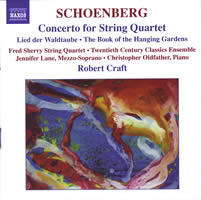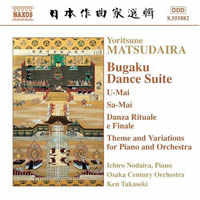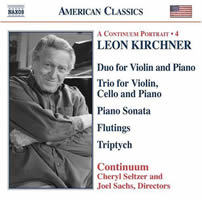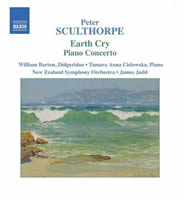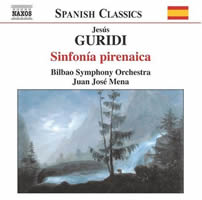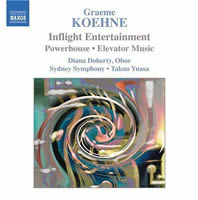A Bowl of Naxos
|
Grant Chu Covell [May 2005.]
Arnold SCHOENBERG: Concerto for String Quartet and Orchestra in B-flat, after the Concerto Grosso Op. 6, No. 7, by G.F. Handel (1933); Suite for Piano, Op. 25 (1921-23); Lied der Waldtaube (from Gurre-Lieder, 1901/11, arr. 1922); The Book of the Hanging Gardens, Op. 15 (1908). The Fred Sherry String Quartet, Christopher Oldfather (piano), Jennifer Lane (mez-sop.), Twentieth Century Classics Ensemble, Robert Craft (cond.); incl. a July 1949 conversation between Halsey Stevens and Schoenberg. Naxos 8.557520 (http://www.naxos.com/). This may very well be the best recording of Schoenberg’s Concerto for String Quartet and Orchestra. (I’ve earlier confessed my fascination with this curiosity here.) No other recordings are necessary; no other ensembles need apply. Veteran new-music star Fred Sherry assembled a string quartet whose sole purpose was to record this piece, and the four soloists capture every madcap nuance. Under Craft’s experienced hand the Twentieth Century Classics Ensemble deftly complies with Schoenberg’s impish demands. The remaining tracks form an atypical collection, vocal music predominating. (Heard from the next room, you might not think this disc features just one composer!) The wood dove’s song from Gurre-Lieder appears in Schoenberg’s chamber ensemble arrangement which redraws the gargantuan original in intimate colors. Jennifer Lane does well in the Gurre-Lieder snippet and in the Op. 15 set where pianist Christopher Oldfather joins her. The five-movement solo piano suite, Op. 25, dates from Schoenberg’s invention of the 12-tone system. Schoenberg employs old forms (minuet, gavotte, musette, etc.) which Oldfather dispatches like Schubert or any other Viennese classic even though the music runs rife with atonal counterpoint and “working with the tones.” There’s a bonus track: Schoenberg in conversation with composer and musicologist Halsey Stevens, previously available on one of Craft’s Schoenberg discs for Columbia Records. Stevens, whose 1953 Bartók book is still essential, sounds like a fawning but practiced radio announcer trying to get a rise out of his subject as quickly as possible. Schoenberg, in his high-pitched Austrian accent, seems titillated by the attention. They chat about music and painting. Archiphon reissued the Kolisch Quartet’s 1936-37 recordings of the four quartets (ARC-103/4) which include players’ and composer introductions. But there’s a trove online at The Arnold Schönberg Center: http://www.schoenberg.at/index.php?option=com_content&view=article&id=938&Itemid=716&lang=en.
Yoritsune MATSUDAIRA: Theme and Variations for Piano and Orchestra (1951); Danza Rituale e Finale (Enbou) (1959); Sa-Mai (1958); U-Mai (1957); Danza Rituale e Finale (Chogeishi) (1959). Ichiro Nodaira (piano), Osaka Century Orchestra, Ken Takaseki (cond.). Naxos 8.555882. One of this year’s most curious and well-done productions: Here is a Japanese writing what sounds like a European writing Japanese music. This unsentimental composer’s idols were Ravel, Poulenc, Milhaud and Tansman. He eventually studied with Alexander Tcherepnin in Tokyo. Disinclined to churn out senseless patriotic ditties, Matsudaira was largely quiet during WWII. In the 1950s he bridged the classical Japanese Gagaku form with Western avant-garde methods, finding many Western champions. Matsudaira’s music progresses with inevitable sureness, demonstrating a knack for movement. Crucially, you can hear how he influenced Boulez and Stockhausen. I hope Naxos is planning future Matsudaira discs. The Theme and Variations for Piano and Orchestra engages the listener’s interest with an uncanny mix of Europe and the Orient. The orchestra, cleverly mimicking shô and biwa, presents an unadorned Gagaku theme. The variations flirt with western preoccupations, including bitonality and what can only be described as Rachmaninoff and Albeniz sipping sake in Tokyo. Just when it seems Matsudaira has no place to go, there’s a serial variation with Bartókian rhythms and then another that explores jazz. According to Morihide Katayama’s detailed notes (he’s the studious annotator for Naxos’ Japanese Classics series), this was the only Japanese work Karajan ever conducted (on a series of 1954 NHK Symphony Orchestra concerts it was paired with Beethoven’s Ninth!). The remaining pieces form the 1957-59 Bugaku Dance Suite. Brief but intensely focused with percussion and agilely twirling flute, Danza Rituale e Finale (Enbou) strings together two suites of under 15-second sighing fragments. One 13-part collection can be played in random order, another six-section passage must be played sequentially. In the five-movement Sa-Mai, “Left Dance,” winds cavort over irregular percussion ostinatos. U-Mai, “Right Dance,” adds strings, brass and piano, but maintains a mysterious air where Webern-like shards spring over evenly paced but varied percussion. Rapidly dissolving gestures color Danza Rituale e Finale (Chogeishi)’s long lines. Scored for orchestra, this satisfying finale’s intricate lines pulse and swell. Boulez, who premiered another work, Figures Sonores, must have had Matsudaira in his ears when he wrote Rituel in memoriam Maderna in 1975.
Leon KIRCHNER: Duo for Violin and Piano (1947); “Flutings” from Lily (1973); Trio for Violin, Cello and Piano (1954); Piano Sonata (1948); Triptych (1986/88). Continuum: Elisabeth Perry, Mark Steinberg, Geoffrey Michaels (violins), Jayn Rosenfeld (flute), Beverly Lauridsen, Maria Kitsopoulos (cellos), Joel Sachs, Cheryl Seltzer (pianos). Naxos 8.559195. Naxos’ fourth “Continuum Portrait” (a pair of Cowell discs occupy first and second position, an Ives disc is third) adds a 1992 recording to four 1983 reissues that feature Kirchner’s expressively assertive music, on a line between Schoenberg and Berg. Continuum’s co-director Cheryl Seltzer delivers a compelling performance of the 1948 Piano Sonata, angular and brooding with primitive rusticity. From the previous year, the violin / piano duo proceeds with inextinguishable momentum. There’s never a dull moment in the robust bipartite piano trio, which warrants greater exposure. The lengthy Triptych, a violin and cello duet, lunges forward several decades. The opening solo cello section reveals a less-hungry Kirchner, though the final parts deliver quick punches among intertwined violin and cello. The meandering solo flute miniature, Flutings, is anomalous among chamber works for strings and piano. Perhaps Kirchner’s expressiveness flew in the face of his colleagues’ more acerbic serialism, but his earnestness refreshes today.
Boris TISHCHENKO: Symphony No. 7, Op. 119 (1994). Moscow Philharmonic Orchestra, Dmitry Yablonsky (cond.). Naxos 8.557013. Without doubt, Tishchenko sounds a lot like Shostakovich, his teacher and idol. However, Tishchenko also worked with Ustvolskaya, whose influence will only be apparent to a few. Symphony No. 7 lives in a cul-de-sac of marches and laments that go nowhere. It would be an enigmatic piece, except for its hardened bleakness. Or maybe it’s an optimistic piece because naïve themes triumph at the end. Tragic or sarcastic, Tishchenko’s Seventh plows through a stunted terrain with its windows rolled up tightly for safety. Possibly Tishchenko has penned a postcard from the land where emotive music no longer has currency, a place whose denizens wonder whether it’s still possible to create meaningful art after the 20th century’s atrocities. The opening theme, as sweetly simple as a clarinet can be, is immediately contrasted with a modernist, Allan Pettersson-like dissonant string smear. The two contrasting ideas (high and low?) bump against each other mercilessly, with mediocrity winning, the clarinet’s theme having turned menacing. At the movement’s high point, Tishchenko strips away the theme’s pitches, leaving only an angry rhythm to be tossed around the orchestra now heavy with percussion. Like Mahler’s Fifth, also in five movements, the clarinet’s theme spills into the second, here a grotesque burlesque plumped with mean-spirited jazz, a reckless piano and obliterating drums. It’s an audaciously ripping scherzo, as fine as any by Tishchenko’s models, Mahler and Shostakovich. The elegiac third movement spins a mournful oboe line into an 11-minute Sibelius-like rhapsody. Finely orchestrated, emphasizing winds and brass, the argument grows louder and increasingly insistent towards the climax. The fourth movement behaves like an intermezzo with its gentler scoring and futile attempts to get a waltz going. There’s also what sounds like a slide whistle. The Finale begins with a spirited patriotic flute and drum tattoo, an unexpected turn after two melancholic movements. It’s unclear whether Tishchenko is at a loss. Perhaps the music is meant to stutter with inconsequential gestures, some which sound like borrowings from south of the Rio Grande. On several enjoyable rehearings, I kept looking for the opening clarinet theme to resurface. After fumbling in the darkness, the symphony ends gleefully with a disingenuous Sousa-like uphill sprint. The applause may surprise. This is a live recording with a remarkably restrained audience. Yablonsky and the Moscow Philharmonic are excellent. Decades ago I reviewed the now-scarce Melodiya recording of Tishchenko’s Fifth (MCD 213). I still find that symphony, a musical memorial for Shostakovich, derivative of its dedicatee. The dim 1985 acoustic suggests Gennadi Rozhdestvensky was barely able to slog the USSR Ministry of Culture Symphony through the demanding and forlorn score. This Seventh is unquestionably the same composer, but Tishchenko has grown mightily in the intervening 18 years. Somebody somewhere ought to start a Tishchenko cycle. Will Naxos step up?
Peter SCULTHORPE: Earth Cry (1986); Memento Mori (1993); Piano Concerto (1983); From Oceania (1970/2003); Kakadu (1988). William Barton (didgeridoo), Tamara Anna Cislowski (piano), New Zealand Symphony Orchestra, James Judd (cond.). Naxos 8.557382. Sculthorpe has been content to go his own way, and for a composer whose locus is Australia and the Pacific region, his music can be the opposite of American and European tendencies. I don’t mean to portray him as an outsider who dabbles in ethnicities as did Harrison, Hovhannes or Partch. His confidence is comparable to Xenakis and Finnissy. Earth Cry combines a growling didgeridoo with orchestra. In four sections, the work exerts a talismanic appeal. There’s no mistaking the primitive-sounding didgeridoo and percussion. Where a less confident composer may pounce upon contrasts, Sculthorpe writes an aggressively modal accompaniment, rich with vigorous counterpoint. The work’s form also defies conventional (and thus European) analysis. Memento Mori builds the Dies Irae into a hymnodic rhapsody with pastoral touches. The Piano Concerto seems the more conventionally designed work: Imagine Bartók abandoned in the Outback, though Sculthorpe limits the savage violence, preferring long Gamelan-scented lines. Soloist and orchestra perform as peers. Note too the strong but never overwhelming brass. The composer omits flutes and clarinets, preferring reedy wind timbres. Opening with conch blasts and dancing percussion, the short From Oceania could easily be mistaken for Revueltas. Northern Australia’s Kakadu National Park inspired Kakadu, a reasonably conventional tone poem whose three sections portray Sculthorpe’s wonderment at the park’s varied landscapes. Under a passionate cor anglais solo, violin glissandi mimic sea gulls. The New Zealand Symphony Orchestra’s strings are exceptionally resonant. I’m reminded of their Lilburn symphonies disc (Naxos 8.555862 reviewed here), and it is a pleasure to hear the orchestra again. Representative all-Sculthorpe discs are rare. Some collections include him as the token Australian or else emphasize his exotic tendencies. Two string quartets discs on Tall Poppies (TP089 and TP090) offer ample evidence of his breadth and resourcefulness.
Jesús GURIDI: Sinfonía pirenaica (1945); Espatadantza, “Sword Dance,” from Amaya (1920). Bilbao Symphony Orchestra, Juan José Mena. Naxos 8.557631. Guridi’s Pyrenaen Symphony depicts the Basque Pyrenees in a lovingly thriving portrait. The Bilbao Symphony Orchestra vivaciously plays the three romantic movements whose hushed opening sets the stage for the impending color. The composer’s style, in line with film-music scoring, effortlessly builds compelling musical narrative from folkloric melodies. Guridi’s evocative vocabulary — hardly cutting-edge for 1945 — employs sudden mood shifts, flexible rhythms, and dark passages ringed with dissonance or bitonality. While Naxos’ cover picture is a dark image, a 19th-century French “Waterfall near the Pont d’Espagne by Moonlight,” I thought of the Husdon River School with its blazing sunsets over rapturous valleys. The under-four-minute Espatadantza, an excerpt from Guridi’s attempt at the definitive Basque nationalistic opera, is meek filler. However, the symphony is a delightful discovery.
Graeme KOEHNE: Elevator Music (1997); Inflight Entertainment (1999); Unchained Melody (1990); Powerhouse (1993). Diana Doherty (oboe), Sydney Symphony, Takuo Yuasa (cond.). Naxos 8.555847. Australian Koehne’s music — billed as “‘Retro’ post-modernism” — would be perfect for a lazy-day pops concert. Powerhouse, Elevator Music, and Unchained Melody form a symphonic trilogy consolidating Koehne’s love for pop music, cartoon music and TV soundtracks. But the neatly orchestrated music, bubbling with perky rhythms and Eisenhower-era naïveté, falls short of its coy titles’ promises. Inflight Entertainment is a fast-slow-fast oboe concerto. Amplified soloist Doherty sacrifices a warm tone to cover the orchestra. The concerto’s central movement, “Horse Opera,” could be used to sell soap flakes or chronicle a hero succumbing to a fatal disease. When John Adams and Michael Torke take pop or nostalgia detours (e.g., The Chairman Dances or Ecstatic Orange) the results are delicious. At some places, say around 3:30 to 4:08 of Unchained Melody, I craved Nyman’s transformation of similar retro material. He would have honed the edges to better effect. Maybe I’m a hopeless hardliner — Koehne could be on to something — but I prefer Carl Stalling or Esquivel’s cheeky joy. The Sydney Symphony plays with polish.
[More Grant Chu Covell, Naxos Bowl]
[Previous Article:
Remembering Arthur Berger]
[Next Article:
Letter from the Provinces]
|
